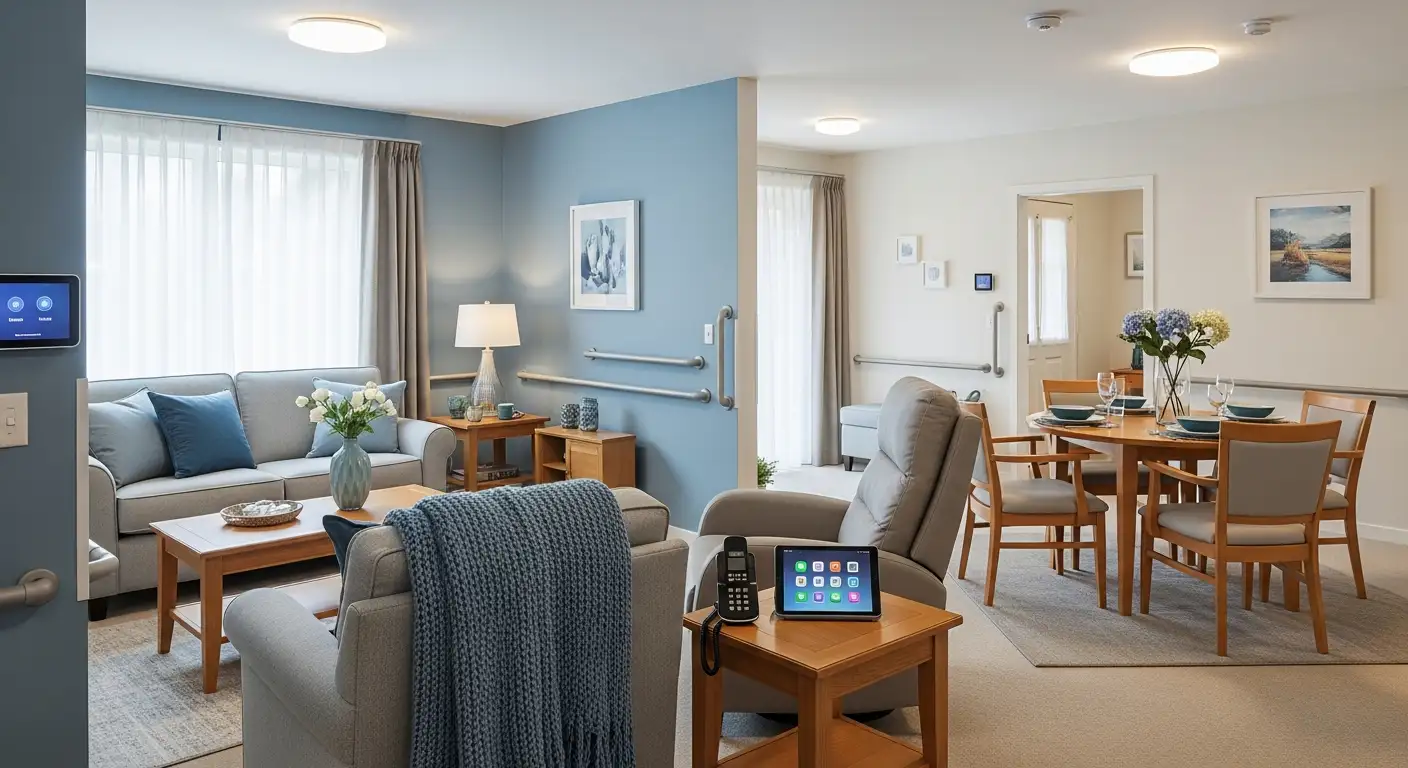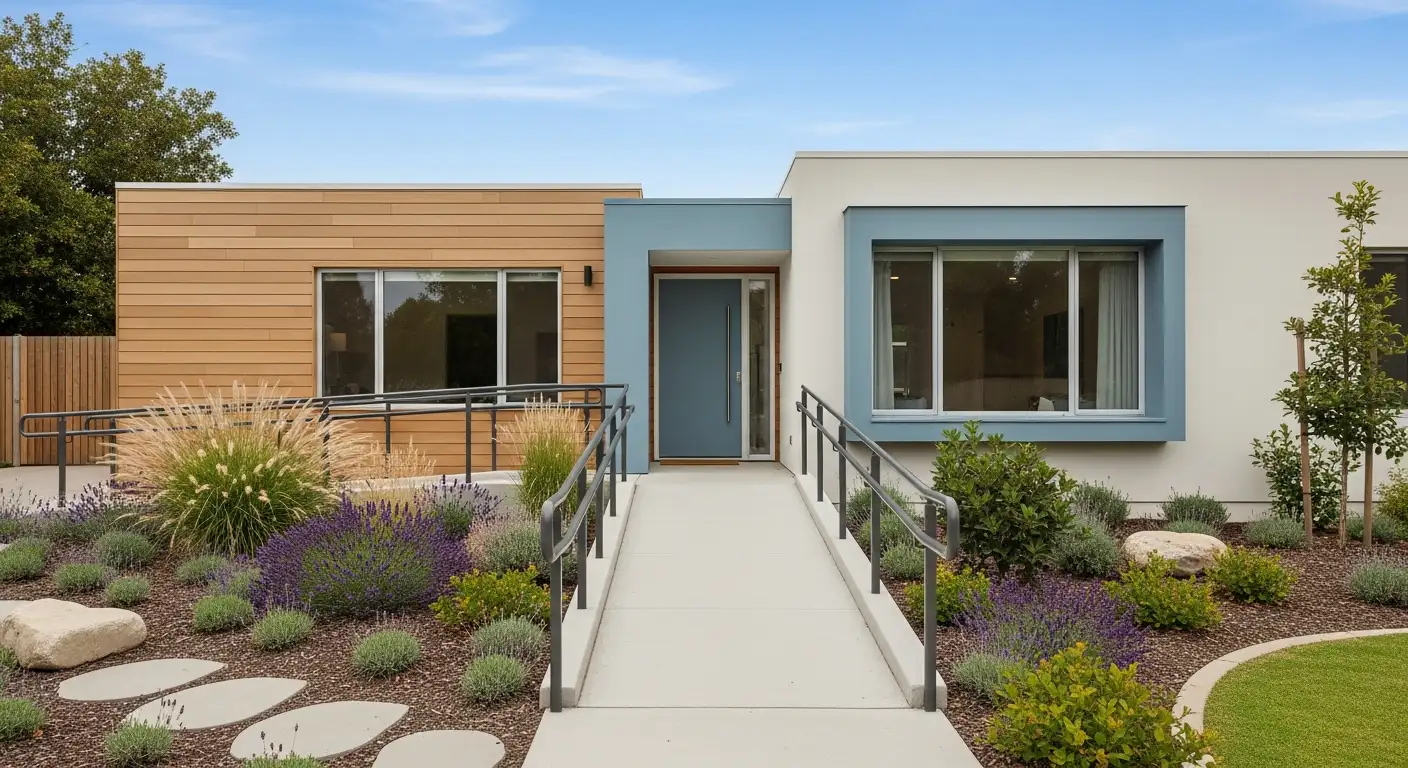The impact of Medicaid waiver programs on long-term care costs
Medicaid Waivers: Shaping the Future of Long-Term Care Financing

Exploring Medicaid Waiver Programs and Their Role in Long-Term Care Costs
Medicaid waiver programs have emerged as pivotal mechanisms in managing long-term care services and costs across the United States. By enabling states to offer customized home and community-based services, these waivers aim to promote aging in place and reduce reliance on expensive institutional care. This article delves into the impact of Medicaid waiver programs, particularly the Medicaid Aging Waivers, on long-term care costs, health outcomes, and service delivery, drawing on the latest research and statistics.
The Scope and Scale of Long-Term Services and Supports (LTSS) in the US
How many people use LTSS and in what settings?
Long-Term Services and Supports (LTSS) are essential for millions of Americans who need assistance with daily activities due to chronic illness, disability, or aging. Over 6 million people receive paid LTSS primarily in home and community settings, reflecting a preference for aging in familiar environments. Additionally, more than 2 million individuals use institutional LTSS services, which include care provided in nursing homes and other residential facilities.
Settings of LTSS Delivery
LTSS can be divided broadly into two categories based on the delivery setting:
Home and Community-Based Services (HCBS): These services allow individuals to receive care in their own homes or community environments. HCBS includes personal care, home health support, adult day care, and home modifications.
Institutional Care: This type of LTSS generally takes place in nursing homes or other residential care facilities designed to provide 24-hour supervision and medical assistance.
The majority of paid LTSS users lean towards home and community-based settings, driven by personal preferences and policies aiming to promote independence.
The Role of Unpaid Care by Family and Friends
Aside from paid services, a significant portion of LTSS is provided unpaid by family members and friends. This informal care forms a critical support network, often helping individuals avoid or delay institutional care. The contribution of unpaid caregivers is substantial, though it remains less visible in official statistics.
Together, these paid and unpaid care sources comprise a comprehensive support system serving vulnerable populations across the United States.
Medicaid’s Dominant Role in Financing Long-Term Care
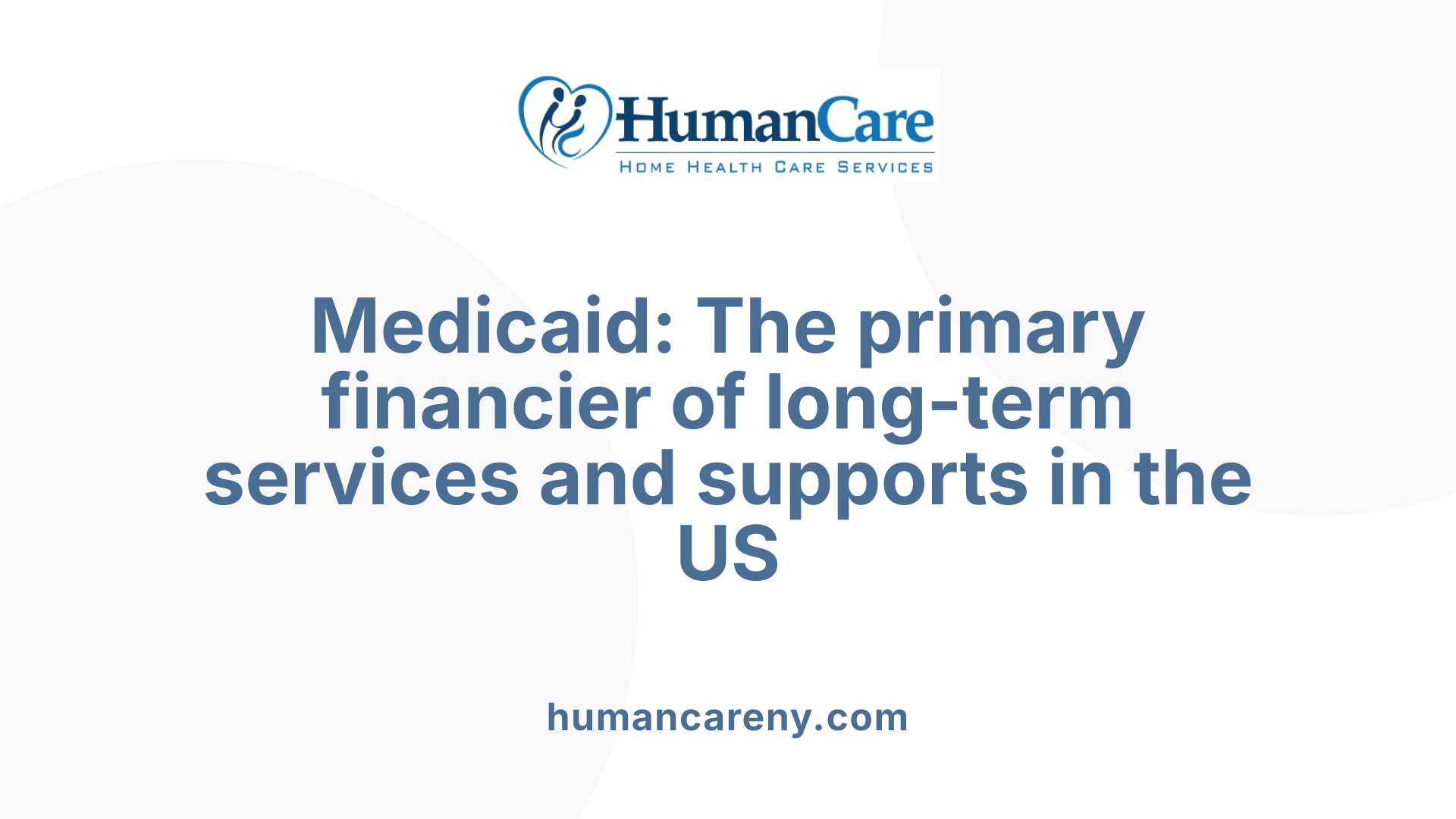
What is Medicaid's role in financing LTSS?
Medicaid plays a crucial role in financing long-term services and supports (LTSS) in the United States. In 2022, it funded approximately 61% of the total US LTSS expenditure, making it the largest public payer for these services.
How does Medicaid support different LTSS settings?
The program predominantly supports home and community-based services (HCBS) rather than institutional care. This focus reflects Medicaid’s policy emphasis on enabling individuals to receive care in their own homes or community settings, aligning with preferences for aging in place and reducing dependence on nursing home placements.
What are recent trends in Medicaid funding for LTSS?
Over recent years, Medicaid’s commitment to HCBS has grown, as evidenced by increasing investments and the expansion of waiver programs allowing states to tailor services. Although Medicaid does cover institutional care, the majority of its resources go toward HCBS, which generally costs less per person and supports better quality of life.
Medicaid’s central role in LTSS financing is reinforced by its extensive coverage of over 6 million people receiving paid home and community-based care. This extensive support system underscores Medicaid’s critical function in enabling access to LTSS for low-income elderly and disabled populations across the country.
Economic Burden of LTSS on Individuals and Families
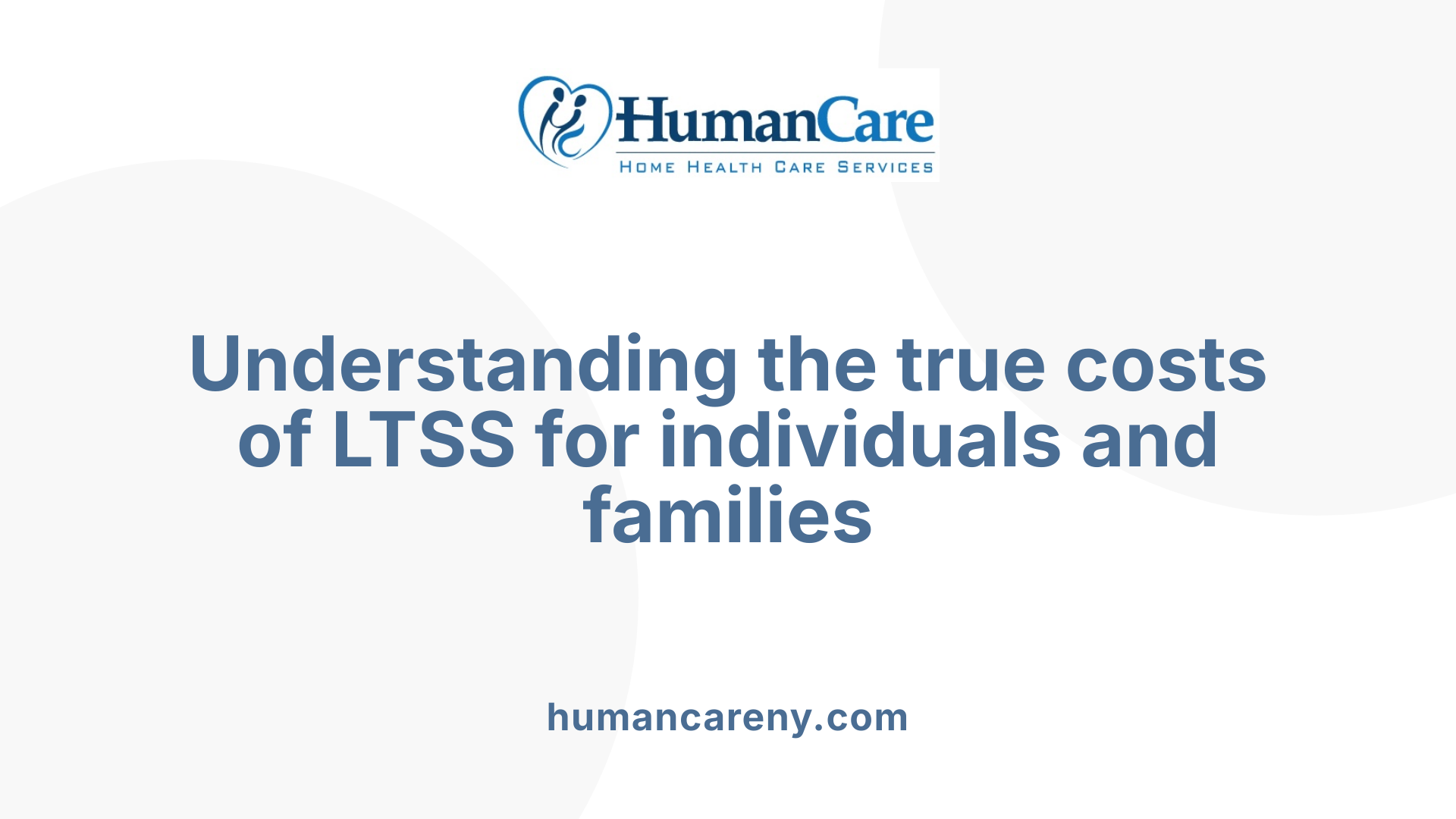
What are the typical costs of LTSS for individuals and families?
Long-term services and supports (LTSS) represent a significant financial challenge for many Americans, particularly as they age. For an average American turning 65, future LTSS costs are estimated to reach approximately $120,900. Families shoulder more than one-third of these expenses out-of-pocket, indicating substantial personal financial responsibility.
How do home health aide costs compare to nursing home expenses?
LTSS costs vary widely depending on the type of care setting. In 2023, the median annual cost for full-time home health aide care was about $68,640. This type of care allows individuals to receive assistance in their own homes but can still be financially demanding.
In contrast, institutional care in nursing homes is notably more expensive. The median cost of a private room in a nursing home reached around $116,800 annually. This figure exceeds the median income of Medicare beneficiaries, highlighting the heavy financial burden nursing home care imposes on older Americans.
These costs not only emphasize the importance of insurance and Medicaid coverage but also underline why many individuals and families struggle with LTSS expenses. Understanding the scope and scale of these costs is essential when planning for long-term care needs and evaluating public policy initiatives aimed at mitigating these economic pressures.
Variability in Medicaid Coverage for Home and Community-Based Services
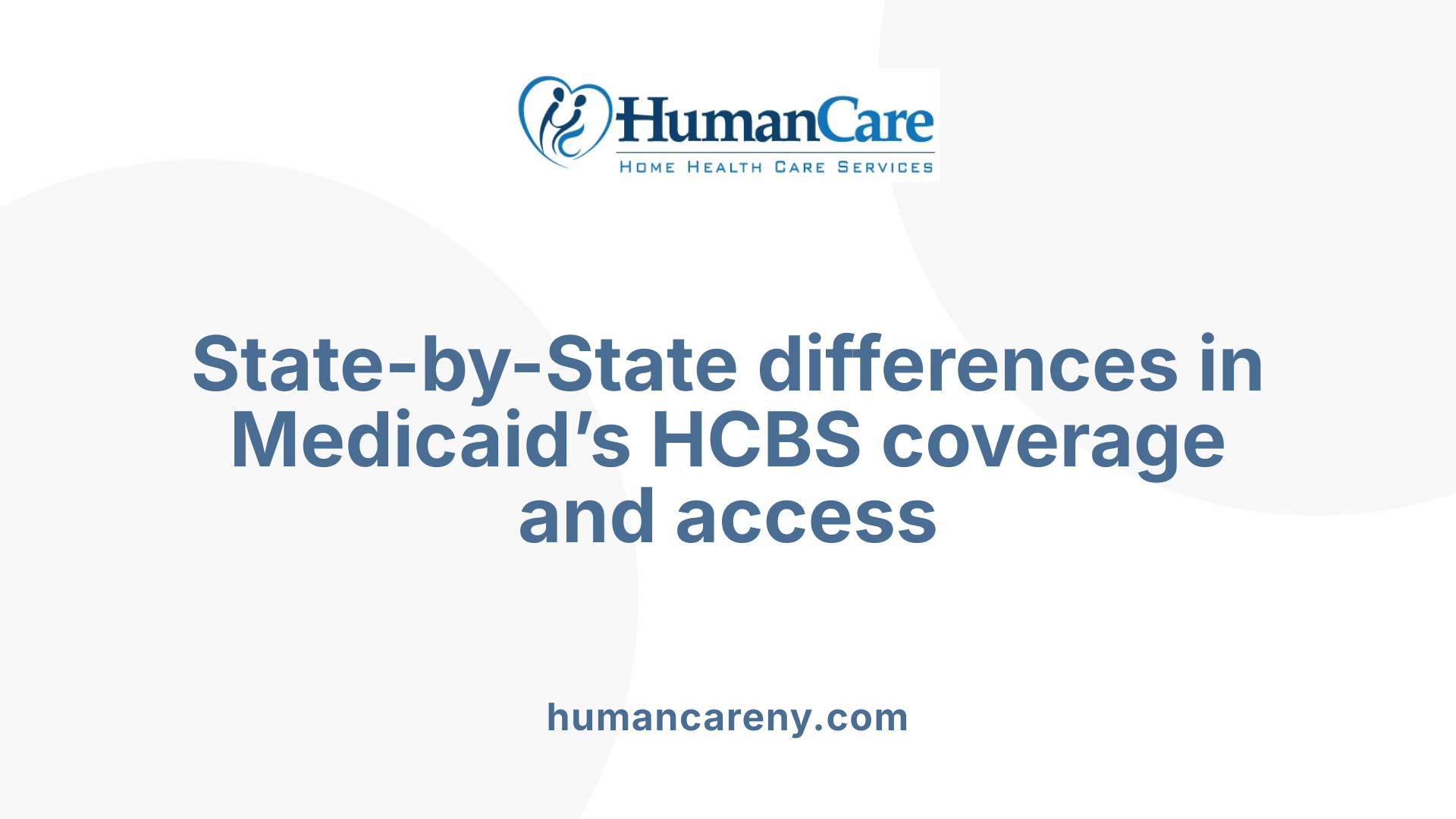
How does Medicaid coverage for home and community-based services vary?
Medicaid plays a crucial role in funding long-term services and supports (LTSS), but its coverage for home and community-based services (HCBS) is not uniform across the United States. Unlike skilled nursing and certain home health services, which Medicaid typically covers, HCBS coverage is optional for states. This results in considerable variability in what services are offered to eligible individuals.
States have the flexibility to decide which HCBS they provide, often using Medicaid waivers or state plan amendments. These services can include personal care, homemaker assistance, adult day care, home modifications, and more. However, coverage can differ widely from state to state in terms of service availability, eligibility criteria, and expenditure levels.
For example, while all states offer programs financing home and community-based services, the extent and scope vary. Some states provide extensive support enabling aging in place, whereas others offer more limited options. This patchwork of coverage means that an individual’s access to necessary services depends heavily on their state of residence.
Moreover, Medicaid waivers that expand HCBS are aimed at providing alternatives to institutional care, but they also often have waiting lists due to limited budgets and program capacity. This variability in coverage and access presents challenges for people who need affordable LTSS outside of institutional settings.
Waiting Lists for Medicaid Home and Community-Based Services
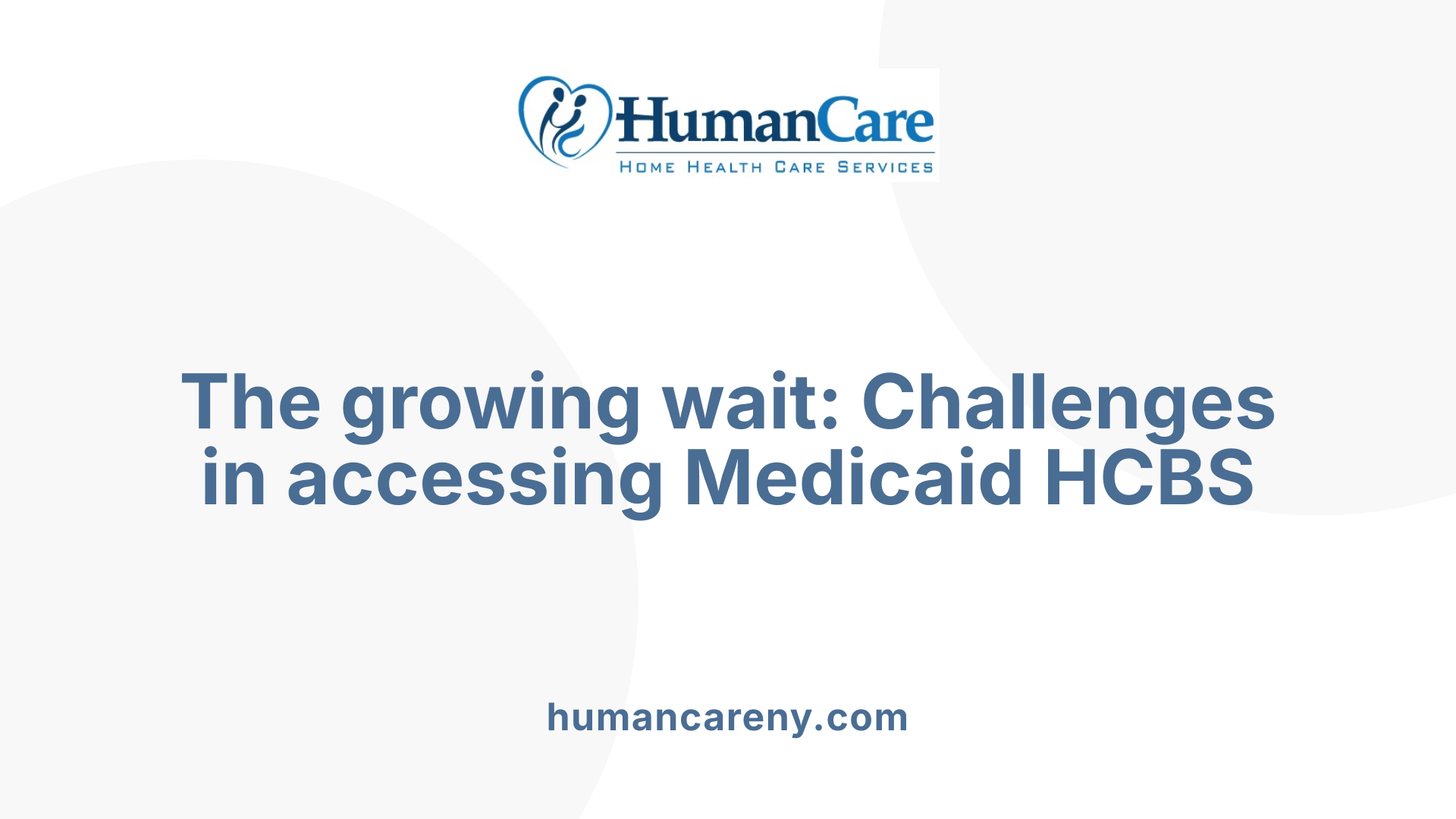
How large are the waiting lists for Medicaid HCBS, and who is on them?
Approximately 700,000 people are currently on waiting or interest lists for Medicaid Home and Community-Based Services (HCBS). The majority of individuals on these lists have intellectual or developmental disabilities, reflecting significant demand among this vulnerable group for supportive services that allow them to live in their communities.
Why do so many people wait for Medicaid HCBS?
The waiting occurs primarily because Medicaid HCBS coverage is optional for states and varies widely by location, contributing to limited and uneven access. Many states have constrained resources and manage program caps that result in long queues for receiving these essential services.
What does this mean for access to care?
These waiting lists indicate a substantial gap between the need for HCBS and the availability of state-funded support. Those on the lists may experience delays in receiving personal care, home health assistance, and other community services critical to maintaining independence and quality of life. Consequently, prolonged waiting may increase reliance on institutional care or unpaid family caregiving, potentially raising both individual hardship and broader healthcare costs.
Limited Role of Private Long-Term Care Insurance
How effective is private long-term care insurance in covering LTSS?
Private long-term care (LTC) insurance plays a relatively small role in covering long-term services and supports (LTSS) compared to Medicaid. In 2021, only about 80,000 claims were filed under private LTC insurance policies. This number is quite low given the total number of policies held nationwide, reflecting limited utilization of these insurance plans.
Number of claims filed versus policies held
Though many Americans hold private LTC insurance policies, actual usage does not match ownership rates. The low claims figure can stem from high premiums, complex policy requirements, and limited benefit coverage that discourage policyholders from filing claims or continuing their plans.
Reasons for low utilization
Private LTC insurance often comes with affordability challenges and strict eligibility criteria. Many individuals find the premiums costly and the benefit period insufficient to cover extended care needs. Moreover, some plans do not cover the full scope of LTSS, such as home and community-based services (HCBS), contributing to underuse.
Comparison with Medicaid coverage
Medicaid is the leading payer for LTSS in the United States, accounting for 61% of total LTSS expenditures in 2022. It predominantly supports HCBS and institutional care for older adults and disabled individuals. Unlike private insurance, Medicaid provides more comprehensive coverage with state-level variations but broader eligibility criteria, making it the primary safety net for most Americans needing LTSS.
The stark contrast between Medicaid’s dominant role and the limited use of private LTC insurance highlights the ongoing challenges in financing long-term care in the U.S., particularly as demand rises with an aging population.
Workforce Challenges in the Long-Term Services Sector
How have workforce shortages affected LTSS?
The Long-Term Services and Supports (LTSS) sector has faced significant workforce shortages, which worsened during the COVID-19 pandemic. Despite efforts to recover, employment levels in LTSS remain below those seen before the pandemic, highlighting ongoing challenges in maintaining adequate care.
States have responded by increasing payment rates for home-based care to attract and retain workers, but these measures have not fully resolved the staffing gaps. Workforce shortages limit the availability and quality of care, impacting both home and community settings where many individuals rely on paid assistance.
These shortages affect the capacity of LTSS providers to meet the growing demand, especially as the aging population expands. The persistent gaps jeopardize timely and effective support for older adults and people with disabilities, underscoring the importance of continued investment and innovative workforce strategies.
Decline in Care Hours in Nursing Facilities
What trends have emerged regarding nursing facility care intensity?
Between 2015 and 2023, there has been a noticeable decline of 9% in the average hours of care provided per resident in nursing facilities. This reduction signals a shift in how long-term care is delivered within institutional settings.
Possible causes and implications
The decline in care hours per resident could be attributed to several factors. Workforce shortages in the long-term services and supports (LTSS) sector, exacerbated by the COVID-19 pandemic, have likely limited the capacity to maintain prior levels of direct care. Additionally, growing cost pressures might restrict the availability of extensive care hours within nursing homes. These factors combined may affect the quality of care residents receive and intensify the demand for alternative care models.
Potential shift toward community-based care
As nursing facility care intensity diminishes, there has been a concurrent policy and population trend toward supporting home and community-based services (HCBS). Medicaid programs have increasingly advocated for services that enable aging in place, such as those provided under Medicaid Aging Waivers (MAW). The emphasis on HCBS may account for some resource reallocation away from institutions and reflects older adults’ preferences to remain in less restrictive environments. However, persistent workforce challenges and state-level variability in service availability continue to influence how this transition unfolds.
Demographic Shifts Increasing Demand for LTSS
How will demographic changes affect LTSS demand?
The share of Americans aged 65 and older is expected to rise from 17% in 2020 to nearly 25% by 2060. This substantial growth in the elderly population will significantly escalate the need for long-term services and supports (LTSS). As more individuals live longer, the prevalence of chronic conditions and disabilities requiring assistance with daily activities will increase.
Implications for LTSS demand
With this demographic shift, the demand for both paid and unpaid LTSS will intensify. Currently, over 6 million people receive paid LTSS in home and community settings, while more than 2 million use institutional care, supported largely by Medicaid. However, workforce shortages in the LTSS sector are already a concern, exacerbated by the COVID-19 pandemic, and may worsen as the elderly population expands. Moreover, waiting lists for Medicaid home and community-based services (HCBS), such as those for people with intellectual or developmental disabilities, highlight the strain on existing resources.
Policy challenges ahead
Addressing this rising demand will require strategic policy initiatives. States must consider expanding Medicaid waiver programs and incentivize workforce growth to increase access to home and community-based care, which is generally less costly than institutional care. Tailored services, like those provided by the Medicaid Aging Waiver (MAW), have proven health benefits for older adults and can help delay nursing home placement. Balancing cost containment with improving quality and availability of services will be crucial as the aging population grows and the demand for LTSS surges.
Introduction to Medicaid Aging Waivers (MAW)
What are Medicaid Aging Waivers and what do they offer?
Medicaid Aging Waivers (MAWs) are specialized programs designed to subsidize the cost of long-term care provided at home or in community settings, encouraging older adults to age in place rather than move into institutional care. These waivers specifically focus on supporting those who require assistance with daily activities without the need for a nursing home.
Purpose and goals of MAWs
The primary goal of MAWs is to promote independence and improve quality of life by offering tailored, flexible care that meets the unique needs of each individual. By providing access to home and community-based services (HCBS), MAWs aim to delay or reduce the reliance on more costly nursing home care, which benefits both the recipients and public programs like Medicaid.
Services included under MAWs
MAWs cover a broad range of HCBS, which generally include personal care assistance, home health care, day care options, and home modifications to enhance safety and accessibility. These services help individuals maintain daily routines and receive the necessary support without relocating to institutional settings.
State variation in program scope
While all states participate in some form of Medicaid waivers for older adults, the scope and coverage of MAWs vary significantly across the country. For example, in 2018, Oregon spent an average of $826 per participant, whereas New Jersey's expenditure was notably higher at $43,066 per participant. This variation reflects different state priorities, budgets, and population needs, resulting in diverse availability and intensity of services.
MAWs play a crucial role in shaping long-term care by enabling personalized, community-based solutions that offer both health improvements and potential cost savings compared to institutional care.
State Variation in Medicaid Aging Waiver Expenditures
How do MAW expenditures differ among states?
In 2018, Medicaid Aging Waiver (MAW) programs operated in 43 states, providing home and community-based services (HCBS) aimed at supporting older adults in delaying or avoiding institutional nursing care. However, the amount each state spent per participant showed significant variation. For instance, Oregon spent approximately $826 per participant, whereas New Jersey's expenditure was dramatically higher at $43,066.
What are potential reasons for this variance?
Several factors contribute to the wide differences in MAW spending among states. Variations in program scope and covered services greatly influence costs—some states offer a broader range of services, including personal care, home health care, adult day care, and home modifications. State policies and eligibility criteria also differ, affecting who receives services and how intensively care is provided. Additionally, cost of living and wage levels for care providers vary regionally, impacting expenditure. States may also differ in their commitment to waiver funding, budget priorities, and administrative structures.
How does spending variation impact access and quality?
Higher expenditures can reflect more comprehensive, tailored services that promote independence and improve quality of life. Increased spending correlates with improved health outcomes, such as reduced reports of poor health, decreased mobility impairments, and better mental health among MAW participants. Conversely, lower spending states may have more limited service options, potentially leading to longer waiting lists and reduced access for those in need. For example, approximately 700,000 people currently await Medicaid HCBS, many with intellectual or developmental disabilities, underscoring access challenges tied to resource allocation.
While some states achieve cost-effective care through targeted programs, others struggle with balancing budget neutrality and expanding service scope. These disparities underscore the importance of tailored state policies that balance costs with quality and accessibility of Medicaid Aging Waiver services.
Health Outcomes Associated with Increased MAW Spending
What health benefits are linked to higher MAW spending?
Empirical studies demonstrate that increased spending on Medicaid Aging Waivers (MAW) significantly improves the health of eligible older adults. Specifically, a $1,000 increase in MAW expenditure per capita correlates with a 1.4% reduction in reports of poor health among recipients.
Specific outcomes affected
This increase in funding also contributes to decreased mobility impairments and fewer limitations in Instrumental Activities of Daily Living (IADLs), such as managing medications or finances. Furthermore, mental health among these older adults shows noticeable improvement, enhancing overall quality of life.
Magnitude and cost-effectiveness of the impact
These positive health outcomes underscore the cost-effectiveness of investing in MAW programs. The research, supported by robust statistical controls and placebo tests, confirms that higher MAW spending leads to tangible health benefits at a relatively modest additional cost. By facilitating greater access to personalized home and community-based services, increased MAW funding not only promotes independence but potentially reduces long-term healthcare expenditures through better health management and reduced need for institutional care.
Validated Research Methods Confirming MAW Impact
How reliable are the findings on MAW program impacts?
Research investigating the effects of Medicaid Aging Waiver (MAW) programs rigorously ensures the reliability of its conclusions by implementing thorough control measures. Studies carefully control for various confounders that could skew results, such as demographic differences, health status, and socioeconomic factors among participants.
To further establish confidence in the findings, researchers conduct robustness checks. These include analyzing the data under multiple scenarios and testing different model specifications to confirm that the observed health benefits of increased MAW spending are consistent and not artifacts of particular analytical choices.
A notable technique employed is the use of placebo tests, where researchers test for effects in groups or periods where no impact is expected. The absence of significant results in these placebo scenarios supports the validity of the positive associations found between MAW expenditure increases and health improvements.
Overall, this multi-layered approach to research design confirms that the documented reductions in poor health reports, decreases in mobility and functional limitations, and better mental health outcomes are genuinely linked to MAW program investments rather than external influences or random variance.
Mechanisms Behind Health Improvements from Medicaid Waivers
Through what channels do Medicaid waivers improve health?
Medicaid waiver programs enhance health outcomes primarily by increasing access to a variety of helpers. These helpers can be paid caregivers providing personal care and home health services or unpaid family and friends offering essential support. This expanded support network enables recipients to better manage daily activities and health needs.
Another crucial channel is the increased utilization of healthcare services. Waiver recipients tend to engage more frequently with healthcare providers, benefiting from timely medical attention, preventive care, and consistent monitoring of chronic conditions. This frequent healthcare interaction helps reduce complications and promotes better health management.
Lastly, Medicaid waivers encourage healthier behaviors among recipients. Evidence indicates that individuals participating in these programs are more likely to reduce harmful habits, such as smoking, which directly contributes to improved physical and mental health.
Together, these mechanisms—greater access to helpers, more healthcare use, and positive lifestyle changes—drive the significant health improvements observed in Medicaid waiver participants. These findings support the cost-effectiveness of Medicaid waiver programs in fostering healthier, more independent lives for older adults and vulnerable populations.
Cost-Effectiveness of Medicaid Home and Community-Based Services
Potential to reduce overall long-term care costs
Medicaid Home and Community-Based Services (HCBS), including Medicaid Aging Waivers (MAWs), are designed to provide alternatives to institutional long-term care by supporting aging in place. By offering tailored, person-centered care such as personal assistance, home health care, and day programs, these services can reduce reliance on costly nursing home care. Although total Medicaid long-term care spending does not always decline—due in part to the 'woodwork effect' where increased access brings more individuals into care—well-managed and targeted HCBS programs often achieve budget neutrality or cost savings by substituting home care for institutional care.
Role in delaying institutionalization
HCBS play a crucial role in delaying or reducing entry into nursing homes. Average monthly costs for Medicaid-funded home and community-based care are significantly lower than nursing home costs, making community care more economically sustainable. States offering MAWs report improved health outcomes among older adults, which is linked to increased use of helpers, better healthcare utilization, and positive behavior changes. These improvements help maintain independence and delay the need for high-cost institutional care.
Quality of life improvements
Beyond economic benefits, Medicaid HCBS notably enhance quality of life. Programs foster independence and tailor services to individual needs, leading to better physical and mental health. Studies find that increased MAW spending corresponds with fewer reports of poor health, reduced mobility and instrumental activities of daily living (IADL) limitations, and improved mental well-being. Such gains underscore the value of community-based care in supporting vulnerable seniors, allowing them to remain in their homes and communities longer.
Do Medicaid HCBS programs reduce long-term healthcare costs?
Investment in Medicaid HCBS, including MAWs, can improve health outcomes and potentially reduce long-term care costs by delaying or preventing expensive nursing home admissions. Evidence suggests that these programs support cost-effective care alternatives that benefit both individuals and Medicaid budgets.
Individualized Assessment and Tailored Care Options in Medicaid Waivers
How Customization of Services Enhances Care
Medicaid waiver programs employ Individualized Assessment to tailor services to the unique needs of each participant. This approach allows for personalized care plans that consider the specific health, mobility, and social requirements of older adults or those with disabilities. By focusing on the individual, these programs provide more relevant home-based and community services, such as personal care, homemaker assistance, and home health care.
Impact on Cost Management
Tailored care options enabled by individualized assessments help manage costs by targeting services that can effectively delay or prevent institutionalization, which is significantly more expensive. For example, the Medicaid Aging Waiver (MAW) subsidizes home and community-based services, promoting aging in place and reducing reliance on costly nursing home care. These targeted services can lead to better health outcomes while also being cost-effective. Evidence shows that increased spending on such tailored programs corresponds to reductions in poor health and functional limitations, indicating better resource utilization.
Examples of Tailored Home-Based Care
Programs like MAWs provide a range of services customized through Individualized Assessment, including home modifications and day care that meet specific needs. States exercise discretion in these programs to ensure flexibility and innovation, enhancing quality of life for recipients. For instance, some programs integrate personal care with mental health support and assistance with activities of daily living, meeting complex care demands.
How Does Individualized Assessment in Waiver Programs Affect Costs?
Medicaid waiver programs use Individualized Assessment to tailor care, providing targeted services that can prevent costly institutionalization and improve cost-effectiveness. By focusing on personal needs and preferences, these programs allocate resources more efficiently, which can reduce unnecessary expenditures on institutional long-term care.
| Aspect | Description | Benefit |
|---|---|---|
| Customization | Individualized Assessment shapes care plans | Improved relevance and effectiveness |
| Cost Management | Targeted home-based services reduce institutional reliance | Potential for significant savings |
| Service Examples | Personal care, home modifications, day care | Enhanced quality of life |
| Health Outcomes | Spending linked to reduced poor health and mobility limits | Better health and function |
Expansion of Home Health Agency Services Through Medicaid Waivers
How do Medicaid waivers expand access to home health agency services?
Medicaid waivers play a crucial role in broadening access to home health agency services by allowing states to offer more flexible and person-centered care options. These waivers empower states to tailor Home and Community-Based Services (HCBS) to meet the diverse needs of elderly and disabled individuals, ensuring that care is customized rather than one-size-fits-all.
Enabling states to offer flexible, person-centered care
States use Medicaid waivers to provide services such as in-home care, personal care, day care, and home modifications. This flexibility supports aging in place and allows beneficiaries to receive essential assistance without needing institutional care. The Medicaid Aging Waiver (MAW), for instance, promotes delayed or reduced reliance on nursing homes by subsidizing long-term care costs directly in home or community settings.
Role in supporting elderly and disabled individuals
Medicaid waiver programs significantly support the elderly and disabled by increasing access to helpers — both paid and unpaid — and facilitating healthcare utilization tailored to each person's circumstances. This person-centered approach improves the quality of life and independence of these populations, enabling them to remain in their homes longer.
Effect on reducing institutional care reliance
By expanding home health agency services through waivers, states can reduce the dependence on costly institutional care such as nursing homes. Home and community-based services are generally less expensive and more desirable for many individuals, potentially decreasing Medicaid’s institutional care spending. However, while waivers can promote this shift, states must manage resources carefully to avoid increasing overall costs due to higher demand for services, sometimes referred to as the "woodwork effect."
Overall, Medicaid waivers are vital tools in reshaping long-term care by expanding home health agency services, fostering a supportive environment for elderly and disabled individuals, and aiming to reduce institutional care reliance.
| Aspect | Description | Example/Impact |
|---|---|---|
| Person-centered care | Tailored home and community services customized per individual needs | Medicaid Aging Waiver adapting services |
| Support for elderly/disabled | Increased access to helpers and healthcare utilization | Improved health, delays institutionalization |
| Institutional reliance impact | Reduces dependency on costly nursing homes through home-based care options | Potential Medicaid savings, but vigilance required |
Medicaid Waivers and Reduction of Institutional Care Costs
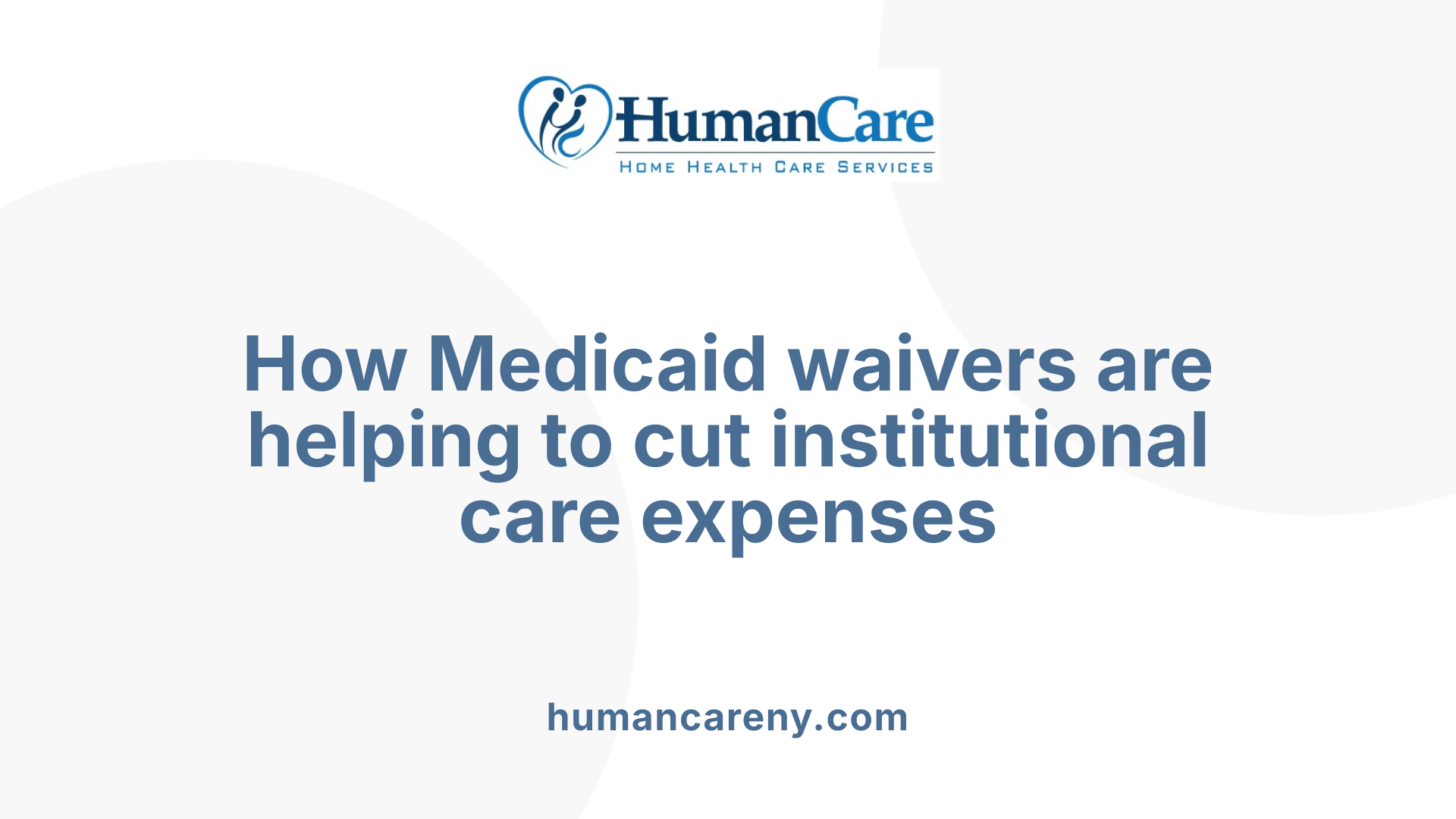
Can Medicaid waivers reduce institutional long-term care costs?
Medicaid waivers, such as the Medicaid Aging Waiver (MAW), aim to subsidize long-term care in home and community settings rather than institutional facilities. These waivers promote access to personal care, home health care, and other community services tailored to individual needs. By offering flexible, person-centered alternatives, waivers encourage aging in place and reduce reliance on expensive nursing homes.
Substitution effect between home care and institutional care
There is evidence that well-managed Medicaid waiver programs can substitute home and community-based services (HCBS) for institutional care. For example, Arizona’s capitated long-term care system demonstrated cost-effective substitution, with savings from reduced nursing home usage. These programs allow older adults and disabled individuals to receive targeted care support while remaining in their homes, enhancing quality of life.
Potential for cost savings
Home and community-based services funded through Medicaid waivers cost significantly less than institutional care. In 1995, the average monthly waiver cost per elderly or disabled client was about $485, compared to $2,426 for nursing home residents. Increased spending on waivers correlates with improved health outcomes, suggesting these programs can be both cost-saving and beneficial for recipients. However, increased access may lead to the "woodwork effect," where more individuals seek services, potentially offsetting savings.
Challenges and limitations
Despite their benefits, Medicaid waiver programs often face budget neutrality requirements, limiting expansion and coverage. Some studies reveal mixed results, especially for mentally ill and developmentally disabled populations, where community-based options produce variable cost and outcome effects. Moreover, persistent workforce shortages and state-level variation in expenditure and service scope pose ongoing challenges to maximizing cost savings.
In summary, Medicaid waivers can reduce institutional long-term care costs by promoting home care alternatives, yet fiscal and implementation complexities temper the overall cost-effectiveness.
Historical Trends in Medicaid Spending on Home and Community-Based Services
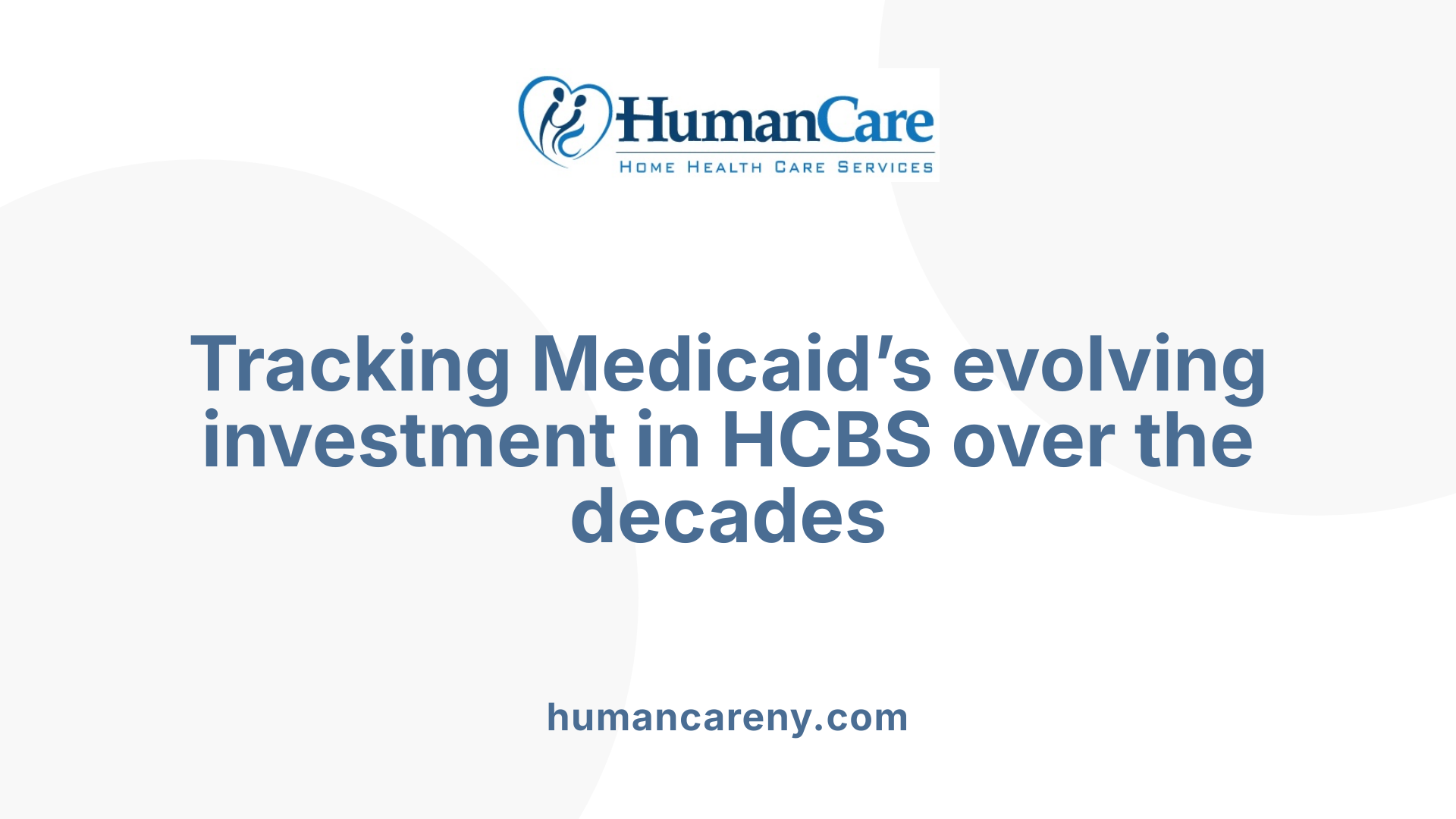
How has Medicaid spending on HCBS evolved historically?
Medicaid's investment in home and community-based services (HCBS) has grown significantly over the past few decades. In fiscal year 1999, Medicaid dedicated approximately $16.4 billion to HCBS, representing 26.2% of its total long-term services and supports (LTSS) expenditure. This marked a considerable portion of resources allocated outside institutional care settings.
Growth of HCBS relative to institutional care
During the mid-1990s, HCBS programs served nearly 1.85 million recipients. Notably, this group accounted for 64% of all Medicaid elderly and disabled long-term care clients at that time. The substantial share indicates a policy shift toward supporting people in their homes and communities rather than in nursing homes or other institutions.
Serving Medicaid elderly and disabled clients
The expansion of HCBS demonstrated Medicaid’s commitment to providing more flexible, person-centered service options tailored for older adults and individuals with disabilities. States have increasingly utilized Medicaid waivers and state plan options to cover a broader spectrum of home health services, promoting aging in place. This transition aimed to improve quality of life while potentially lowering overall care costs by balancing institutional and community-based care needs.
| Year | Medicaid HCBS Expenditure | Percent of Total Medicaid LTSS | Recipients Served | Percent of Medicaid Elderly & Disabled Served |
|---|---|---|---|---|
| 1995 | N/A | N/A | ~1.85 million | 64% |
| 1999 | $16.4 billion | 26.2% | N/A | N/A |
This historical trajectory underscores increased Medicaid support for HCBS, encouraging more community-based care options alongside institutional care.
Federal Legal Framework Supporting Medicaid Waivers for HCBS
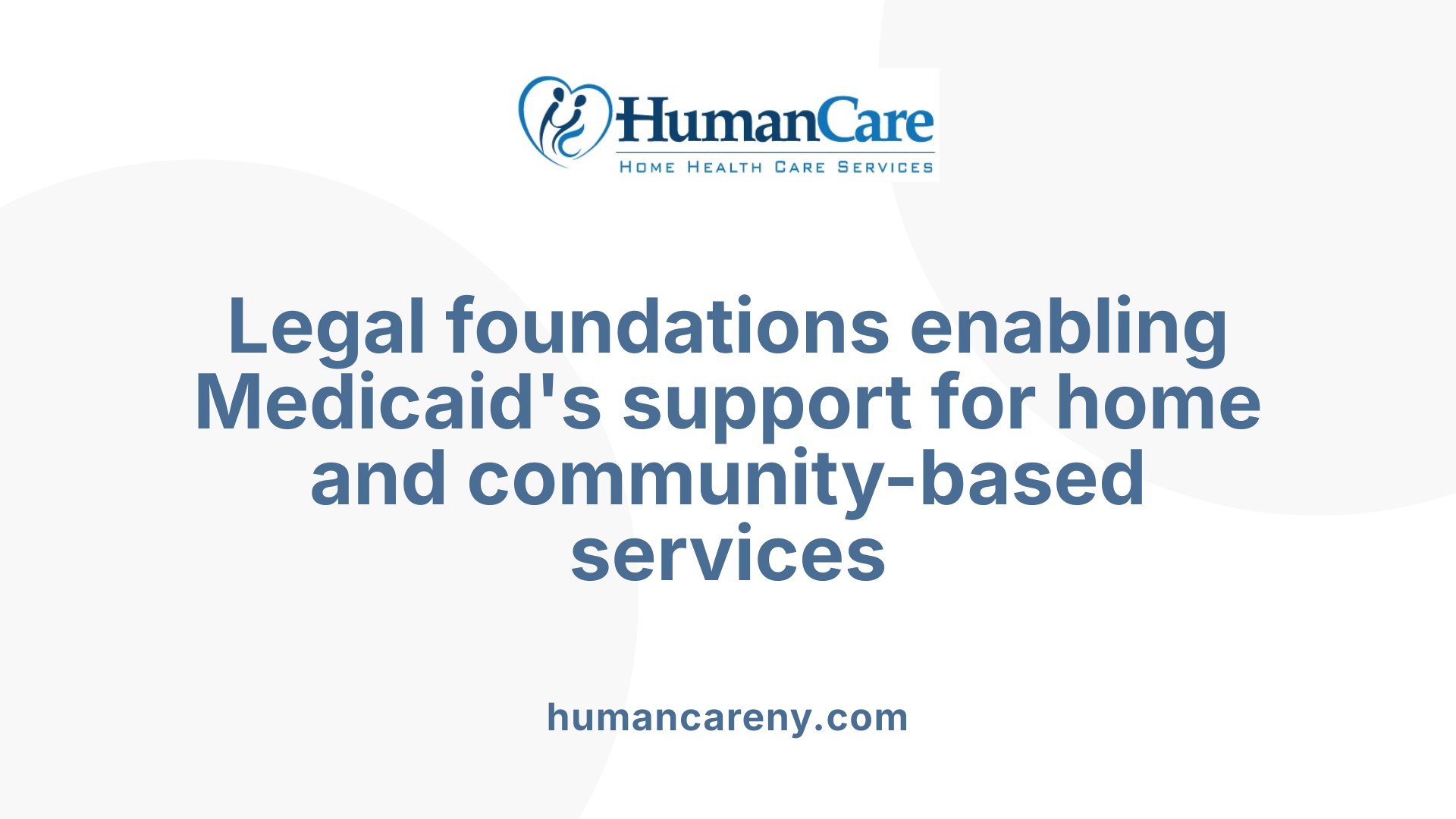
What federal laws allow states to offer Medicaid waivers for HCBS?
Federal laws grant states the authority to request Medicaid waivers that enable coverage of home and community-based services (HCBS). These waivers allow states to provide non-professional services as alternatives to institutional care, targeting populations with specific long-term care needs—such as older adults, individuals with disabilities, or those with mental health challenges.
Federal permission for state waiver requests
The Medicaid program under federal law includes provisions that permit states to seek waivers, broadly enhancing flexibility in service delivery. These waivers bypass some standard Medicaid requirements, allowing states to develop person-centered, community-oriented programs tailored to the needs of vulnerable populations.
Use of waivers for non-professional services
Through waiver programs, states can fund a variety of services outside traditional institutional care, including personal care, homemaker assistance, adult day care, habilitation, and home health services. These non-professional services are essential to support individuals in community settings, promoting independence and quality of life.
Targeting specific populations
Medicaid waivers typically focus on specific groups requiring long-term support—such as the elderly, persons with intellectual or developmental disabilities, and those with chronic mental illness. They enable states to customize the types and intensity of services while managing costs and improving health outcomes.
By allowing such targeted and flexible approaches, federal laws underpin the widespread use of Medicaid HCBS waivers, driving innovations that balance care quality and fiscal responsibility.
Cost Comparison Between Institutional Care and Medicaid HCBS
How do costs of Medicaid HCBS compare to nursing home care?
In 1995, Medicaid-covered Home and Community-Based Services (HCBS) for elderly and disabled clients averaged about $485 per month. In stark contrast, nursing home care cost approximately $2,426 monthly for residents. This striking difference highlights the substantial cost savings potential of HCBS as an alternative to institutional care.
Average monthly cost for nursing home versus home care
The cost disparity illustrates why many states and policymakers focus on expanding HCBS options. Institutional care, such as nursing homes, involves high levels of skilled nursing and facility expenses, driving up costs. Conversely, HCBS—including personal care, homemaker services, and day care—offer more affordable, flexible support tailored to individuals living in their own homes or communities.
Cost savings potential of HCBS
By emphasizing HCBS, states can potentially lower Medicaid expenditures while improving quality of life. These lower costs stem from reduced facility overhead and the ability to provide services on a needs basis rather than comprehensive institutional care. Such savings are critical given Medicaid’s large role in funding long-term services and supports (LTSS).
Implications for Medicaid budgets
States aim to manage their budgets with budget neutrality clauses in waiver programs, carefully balancing expanded HCBS access without increasing overall costs. While the “woodwork effect” — where more individuals seek Medicaid services than before — can increase total spending, well-managed HCBS programs can substitute for nursing home care, offering valuable cost-effectiveness. Expanding HCBS may ease Medicaid's financial pressure and better meet the growing demand for community-based LTSS as the aging population rises.
The 'Woodwork Effect' and Its Impact on Medicaid LTSS Costs
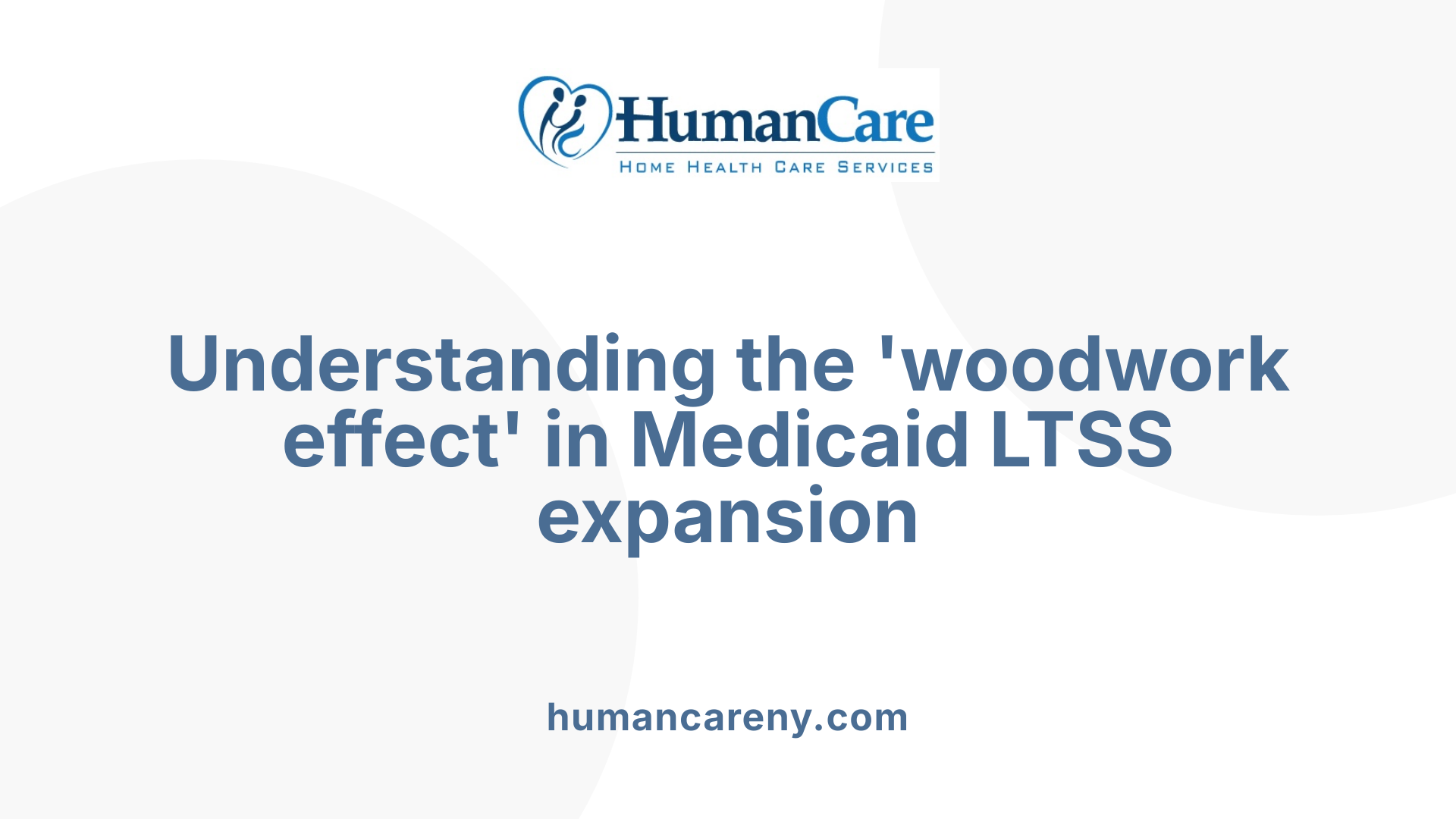
What is the woodwork effect and how does it affect Medicaid costs?
The woodwork effect refers to a phenomenon where expanding access to Home and Community-Based Services (HCBS) under Medicaid encourages more individuals to utilize long-term services and supports (LTSS) who may not have previously sought institutional care. Essentially, instead of merely substituting costly nursing home services, these expanded options bring additional beneficiaries into the system.
Definition and consequences of the woodwork effect
While HCBS programs aim to reduce reliance on institutional care by providing alternative services at home or in the community, the woodwork effect can lead to increased overall Medicaid LTSS spending. This occurs because some newly served individuals might not have qualified or sought care without the availability of these services, thus increasing the total number of beneficiaries and driving up aggregate costs.
How expanded HCBS access influences overall costs
States implementing Medicaid HCBS waivers usually seek budget neutrality, but the woodwork effect challenges this goal. Although the monthly cost of home and community-based care is notably lower than that of nursing home care—for example, monthly costs in 1995 averaged $485 for HCBS versus $2,426 for nursing home residents—the expanded enrollment caused by the woodwork effect can offset potential savings.
Balancing access and cost containment
Programs must carefully design eligibility criteria and service packages to manage this balance. Well-managed, targeted HCBS programs, like Arizona's capitated long-term care system, have demonstrated some success in substituting home care for nursing home use and achieving cost savings.
The challenge for Medicaid is to maximize access to person-centered, community-based care while maintaining fiscal responsibility. Careful policy design and ongoing evaluation are crucial to mitigating the woodwork effect's impact and improving outcomes without unsustainable cost increases.
Budget Neutrality and Access Constraints in Medicaid Waiver Programs
How does budget neutrality influence Medicaid waiver program design?
States often pursue budget neutrality in designing Medicaid waiver programs to control long-term care expenditures. This fiscal goal mandates that waiver spending should not significantly increase total Medicaid costs, encouraging strict management of resources.
Effect on service access and benefits
The quest for budget neutrality typically leads states to restrict access by limiting eligibility or reducing covered services. These constraints can curtail the number of beneficiaries and limit the scope of benefits available through Medicaid waivers. Such limitations may prevent some individuals from receiving home and community-based services (HCBS) that could be alternatives to institutional care.
Strategies to achieve cost-effective care
Despite access constraints, targeted and well-managed Medicaid waiver programs can effectively substitute for nursing home care. States like Arizona have implemented capitated long-term care systems that demonstrate cost savings and efficient resource use. By focusing resources on individuals most likely to benefit, programs can improve outcomes while adhering to budget goals.
These approaches underscore the delicate balance between managing costs and providing adequate home and community-based long-term services and supports, aiming to optimize quality of life while containing Medicaid spending.
Successful Models of Medicaid Waivers Substituting Home Care for Nursing Homes
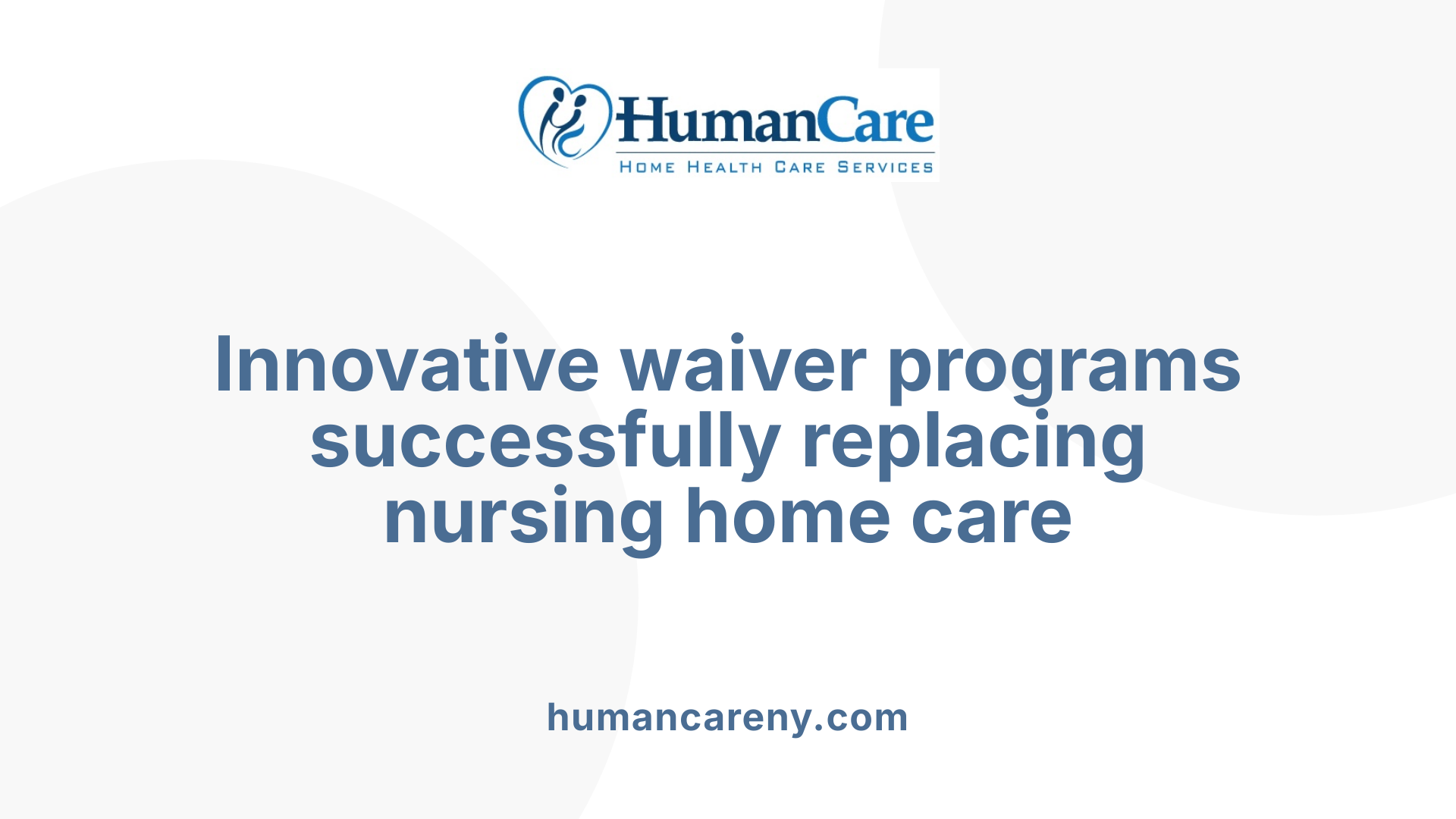
Are there examples of effective Medicaid waivers reducing nursing home use?
One notable example is Arizona’s capitated long-term care system, which has effectively substituted home care for nursing home services. This model provides a managed care approach where payments are capitated, meaning providers receive a fixed amount per person to cover all necessary long-term services and supports.
Case studies like Arizona’s capitated long-term care system
Arizona's system focuses on delivering person-centered care through home and community-based services (HCBS). By targeting care to suit individual needs, the program aims to reduce dependency on more costly institutional care while enhancing quality of life.
Savings achieved
This approach has resulted in measurable cost savings by shifting beneficiaries away from expensive nursing home placements toward home care options. Such savings come from lower average costs for HCBS compared to institutional care—for example, the average monthly cost for home and community-based waiver clients is significantly lower than that for nursing home residents.
Lessons learned
Key lessons from Arizona’s model include the importance of budget neutrality targets, which help restrict unnecessary expenditures. However, programs must balance cost control while ensuring adequate access to services. Well-managed, targeted waivers demonstrate that it's possible to contain or reduce long-term care costs through tailored community-based care.
Overall, Arizona’s capitated system highlights how Medicaid waivers can play an instrumental role in reducing nursing home use, controlling expenditures, and promoting aging in place—key objectives of Medicaid home and community-based service programs.
Medicaid Waivers for Mentally Ill and Developmentally Disabled Populations
Outcomes in Community-Based Care Versus Institutions
Medicaid waivers aim to provide alternatives to institutional care for mentally ill and developmentally disabled populations by supporting smaller residential facilities and community-based services. These programs often focus on promoting independence and improving quality of life through personalized care options, enabling individuals to live in less restrictive environments.
Mixed Research Findings on Cost Savings
Studies evaluating these waiver programs report mixed results. Several instances demonstrate cost savings and enhanced community outcomes when smaller residential settings or community services substitute institutional care. For example, some states have seen effective management of long-term care expenditures while improving client satisfaction and autonomy.
Challenges with the Woodwork Effect
Despite potential benefits, these programs face challenges such as the "woodwork effect," where increased availability pulls additional individuals into services who may not have otherwise required institutional care. This effect can mitigate expected cost reductions, as expanding access sometimes increases overall service utilization and expenditure.
How Effective Are Waivers for Mentally Ill and Developmentally Disabled Groups?
Research indicates that Medicaid waivers for these populations have variable effectiveness. While well-structured programs can substitute home care and community services for institutional placements, delivering both cost efficiency and quality outcomes, the woodwork effect and variability in state implementations complicate achieving consistent cost savings. Careful program design and management remain essential to balance access, cost, and quality in serving these vulnerable groups.
Growing Importance of Home Health Agency Services within Medicaid Waivers
What role do home health agencies play in Medicaid waiver programs?
Home health agencies are integral to Medicaid waiver programs, delivering crucial in-home care services that enable elderly and disabled individuals to receive support without institutionalization. These agencies provide personal care, skilled nursing, and assistance with daily living activities, forming a core component of Home and Community-Based Services (HCBS) that Medicaid waivers promote.
Supporting elderly and disabled needs
Medicaid waivers, such as the Medicaid Aging Waiver (MAW), leverage home health agency services to address the complex care needs of older adults and those with disabilities. By offering tailored, person-centered care, these agencies help maintain the independence and quality of life of recipients. This support reduces reliance on nursing home care, which is more costly and often less preferred by individuals.
Enhancing community-based services
Home health agencies expand access to community-based care by enabling states to provide flexible services through waiver programs. These services include nursing care, therapy, and health monitoring, supplemented by homemaker and personal care aides. As a result, beneficiaries can age in place safely and healthily, with evidence showing that increased Medicaid waiver spending correlates with improved health outcomes.
In summary, home health agency services are foundational to Medicaid waiver programs, facilitating effective in-home care, supporting vulnerable populations, and promoting cost-effective community-based alternatives to institutional care.
Medicaid Waivers and Tailored Service Planning for Better Outcomes
How do Medicaid waivers promote tailored service delivery?
Medicaid waivers enable states to provide person-centered care planning by utilizing individualized assessments. This approach focuses on the specific needs and preferences of each participant rather than using a one-size-fits-all model.
These waivers offer flexibility in service offerings, allowing states to design and deliver a variety of home and community-based services (HCBS) such as personal care, home health care, day care, and home modifications. The broad scope under Medicaid waivers means that programs can be uniquely tailored to enhance support for older adults and individuals with disabilities.
Impact on quality of life
Tailored service planning under Medicaid waivers leads to improved quality of life by promoting independence and enabling aging in place. Empirical evidence shows higher Medicaid Aging Waiver (MAW) expenditures correlate with better health outcomes, such as reduced reports of poor health, fewer mobility and instrumental activities of daily living (IADL) limitations, and improved mental health.
The individualized nature of these programs fosters innovation and flexibility, allowing states to adapt services to meet evolving needs. This focused approach not only supports vulnerable populations effectively but also offers potential cost savings by reducing dependence on expensive institutional care.
In summary, Medicaid waivers facilitate an adaptable, person-centered framework that advances tailored care delivery and enhances life quality for older adults and others in need of long-term services and supports.
The Role of Family and Unpaid Caregivers in Medicaid Waiver Programs
How are unpaid caregivers involved in Medicaid waiver-supported care?
Family and unpaid caregivers play a crucial role in the delivery of long-term services and supports (LTSS), particularly within Medicaid waiver programs. These caregivers often work alongside paid, Medicaid-funded home and community-based services (HCBS) to provide comprehensive care tailored to the needs of older adults and individuals with disabilities.
Complementing paid services
Unpaid caregivers often help with daily activities such as personal care, household tasks, and medication management. Their involvement complements paid services funded through Medicaid Aging Waiver (MAW) programs, enhancing the overall level and continuity of care these individuals receive. By filling in care gaps and providing emotional support, unpaid family members become vital partners in the care network.
Relieving pressure on formal care systems
The substantial contributions of unpaid caregivers alleviate pressure on formal care systems, allowing Medicaid waiver programs to extend resources effectively. This combined effort reduces the demand for institutional care, aligning with the goal of MAW initiatives to promote aging in place and community living.
Influence on overall cost dynamics
From a financial perspective, unpaid caregiving helps moderate overall LTSS costs. By delivering essential informal care, family members reduce reliance on higher-cost institutional services and lessen the intensity or frequency of paid supports needed. This dynamic supports Medicaid waivers’ cost-effectiveness by enabling more individuals to remain in less costly home-based settings.
In summary, unpaid caregivers are indispensable within Medicaid waiver frameworks, complementing formal services, easing system burdens, and influencing cost trajectories positively through their substantial, though often unrecognized, caregiving contributions.
State Policy Variations Impacting Medicaid Waiver Effectiveness
How do state policy choices affect Medicaid waiver program outcomes?
State policies play a crucial role in shaping the success of Medicaid waiver programs, which are designed to provide home and community-based services (HCBS) as alternatives to institutional care. These policies affect eligibility criteria, the range of benefits offered, payment rates, and strategies to manage workforce challenges.
Differences in eligibility and benefits
Eligibility for Medicaid waivers varies significantly between states, influencing who can access these services. Some states prioritize populations such as older adults or individuals with intellectual and developmental disabilities, often leading to waiting lists—in some states, about 700,000 people are waiting for HCBS, mostly with developmental disabilities.
States also differ in the scope of benefits under waivers. Services may include personal care, home health care, day care, and home modifications, but which ones are available varies. For example, while Oregon spent roughly $826 per participant on these services in 2018, New Jersey’s spending was $43,066, reflecting broad variation in service intensity and availability.
Payment rate adjustments
To support the waiver programs, states have increased payment rates for home-based care. However, persistent workforce shortages continue to challenge service delivery. These payment adjustments aim to attract and retain caregivers by offering competitive wages but are often insufficient to resolve staffing needs fully.
Workforce considerations
Workforce shortages in LTSS have worsened, especially after the COVID-19 pandemic, with employment levels still below pre-pandemic numbers. This shortage limits the capacity of waiver programs to deliver timely and quality care, affecting the effectiveness of state waivers.
Overall, the variation in state policy decisions around eligibility, benefits, payment, and workforce management directly impacts the accessibility, quality, and outcomes of Medicaid waiver programs. States that invest more in comprehensive, tailored services and address workforce challenges tend to see better health outcomes and greater program effectiveness.
Balancing Cost, Access, and Quality in Medicaid Waiver Programs
What challenges exist in balancing cost, access, and quality in Medicaid waivers?
Medicaid waiver programs face the complex challenge of controlling costs while ensuring that eligible older adults have both access to services and high-quality care. These programs must navigate budget constraints, often striving for budget neutrality, which can limit the scope of services and the number of participants. Despite these limits, effectively designed waivers can provide tailored home and community-based services (HCBS) that substitute for expensive nursing home care, promoting aging in place and improving health outcomes.
Tradeoffs in program design
One primary tradeoff involves managing the demand for services versus available funding. Expanding access to HCBS may trigger the 'woodwork effect,' where individuals who might not have used institutional care start receiving services, thus increasing overall costs. States try to balance availability with cost by carefully selecting service packages and eligibility rules under waiver programs. Well-managed programs, like Arizona’s capitated long-term care system, successfully cut nursing home use and control expenses, showing that strategic planning can align cost savings with better care.
Importance of innovation and flexibility
Medicaid waivers offer states flexibility to innovate, tailoring services to participants' needs. This flexibility allows incorporation of services such as personal care, home health care, and home modifications, which help maintain independence and quality of life. The variability in program scope across states exemplifies how innovation enables responsiveness to diverse populations and changing demand, especially given workforce shortages and evolving care standards.
Strategies for sustainable long-term care
Sustainability rests on enhancing service effectiveness and cost-efficiency. Increasing expenditure on Medicaid Aging Waivers correlates with significant health improvements, including reduced poor health reports and mobility limitations. Improved health outcomes can lead to lower long-term healthcare costs. Strategies include expanding in-home aide availability, encouraging healthier behaviors, and integrating paid and unpaid care networks. Maintaining workforce capacity through higher payment rates, while addressing shortages, remains critical for scalable HCBS delivery.
Balancing cost, access, and quality in Medicaid waiver programs requires ongoing adaptation, informed by empirical evidence and targeted innovation, ensuring that growing populations receive effective, community-based long-term care options.
The Future Outlook for Medicaid Waivers Amidst Rising LTSS Demand
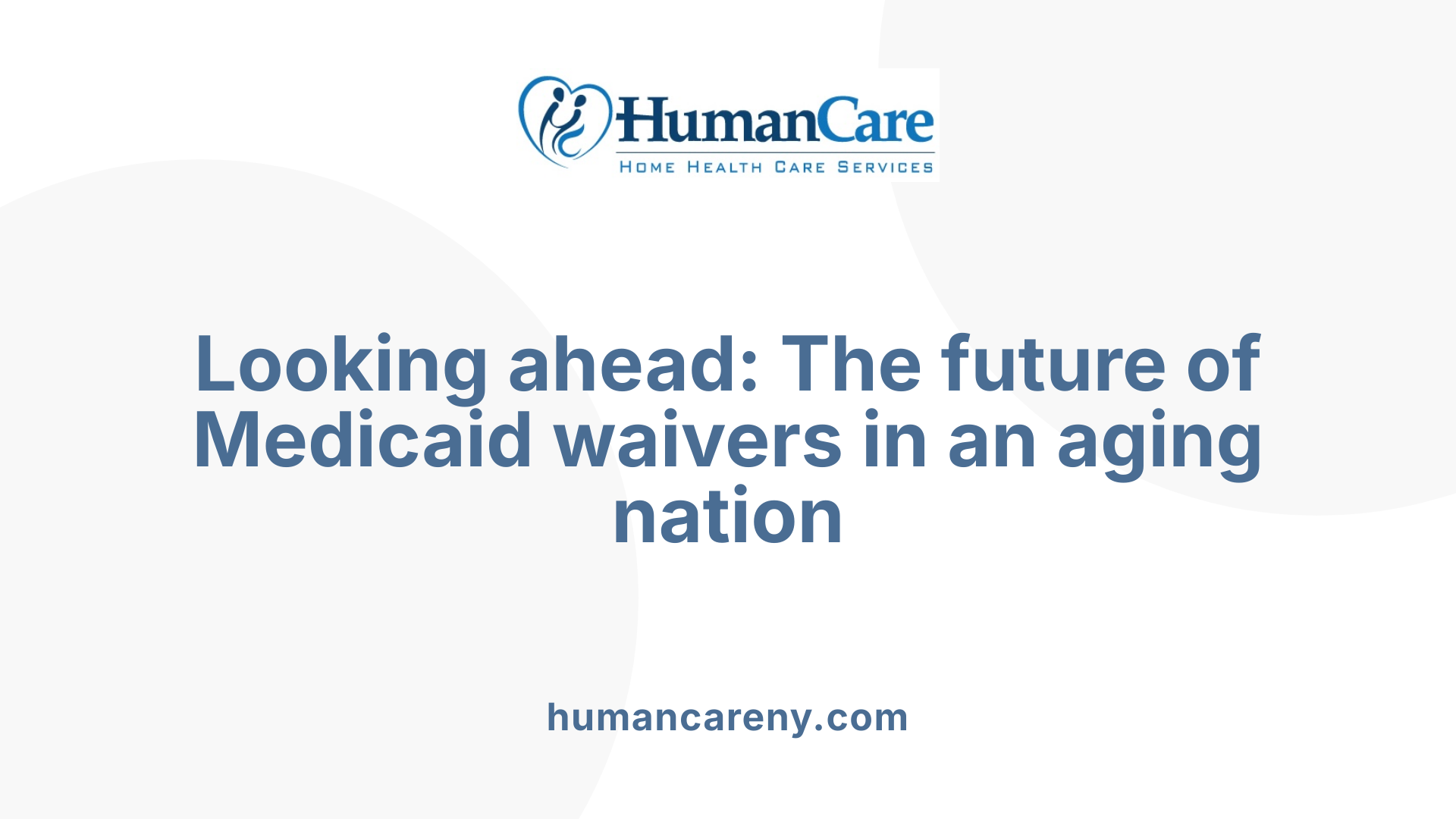
What does the future hold for Medicaid waivers with rising LTSS demand?
The United States faces a significant increase in its elderly population, with projections indicating that those aged 65 and older will grow from 17% in 2020 to nearly 25% by 2060. This demographic shift will inevitably drive higher demand for Long-Term Services and Supports (LTSS).
To accommodate this growing need, Medicaid waivers such as the Medicaid Aging Waiver (MAW) will play an essential role in expanding access to home and community-based services (HCBS). These waivers help older adults live independently by subsidizing in-home care and other supportive services, reducing the reliance on costly institutional care like nursing homes.
Policy efforts will need to focus on adapting existing programs and increasing funding to enhance waiver capacity. Given workforce shortages and the varying scope of services across states, lawmakers must prioritize investments in HCBS to ensure quality care is widely available. Well-designed waiver programs have already demonstrated improvements in health outcomes and cost-effectiveness, which further supports their expansion.
Ultimately, Medicaid waivers offer a promising strategy to meet rising LTSS demands, promote aging in place, and potentially control long-term healthcare costs through tailored, person-centered care delivered in community settings.
Medicaid Waivers as a Cornerstone of Sustainable Long-Term Care
Medicaid waiver programs, particularly those supporting home and community-based services, have demonstrated their potential to improve health outcomes and manage long-term care costs effectively. While challenges such as workforce shortages, the woodwork effect, and state-by-state variability persist, evidence supports the cost-effectiveness and essential role of these programs in enabling aging in place and reducing institutional care reliance. As the aging population grows, Medicaid waivers will remain crucial for delivering personalized, affordable long-term care, balancing quality with budget considerations, and fostering innovative care models for vulnerable populations.








